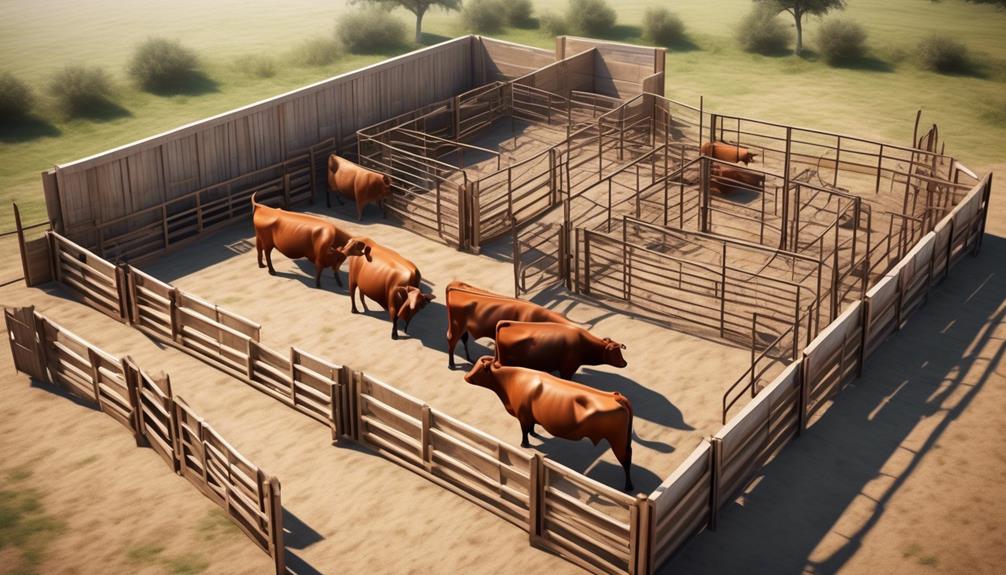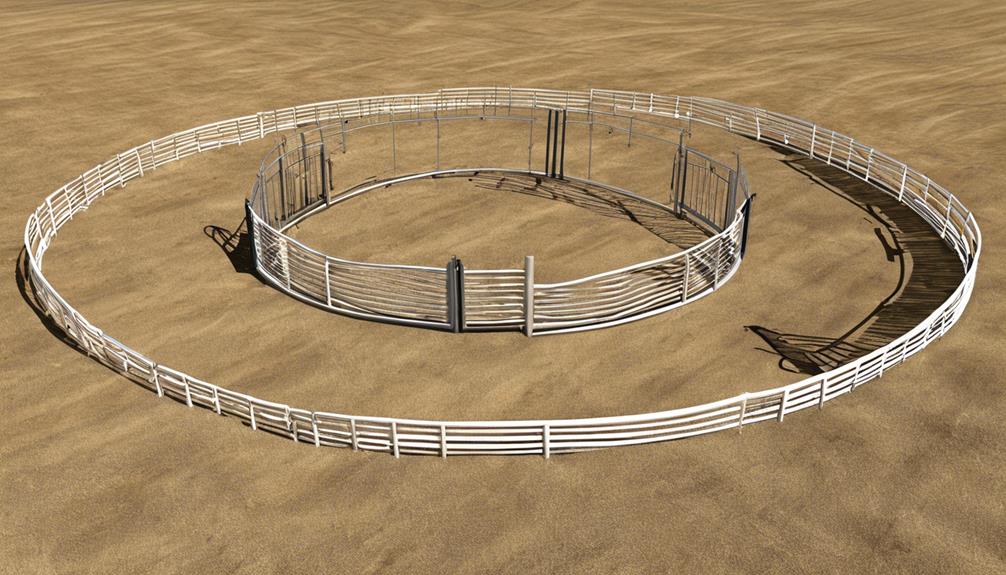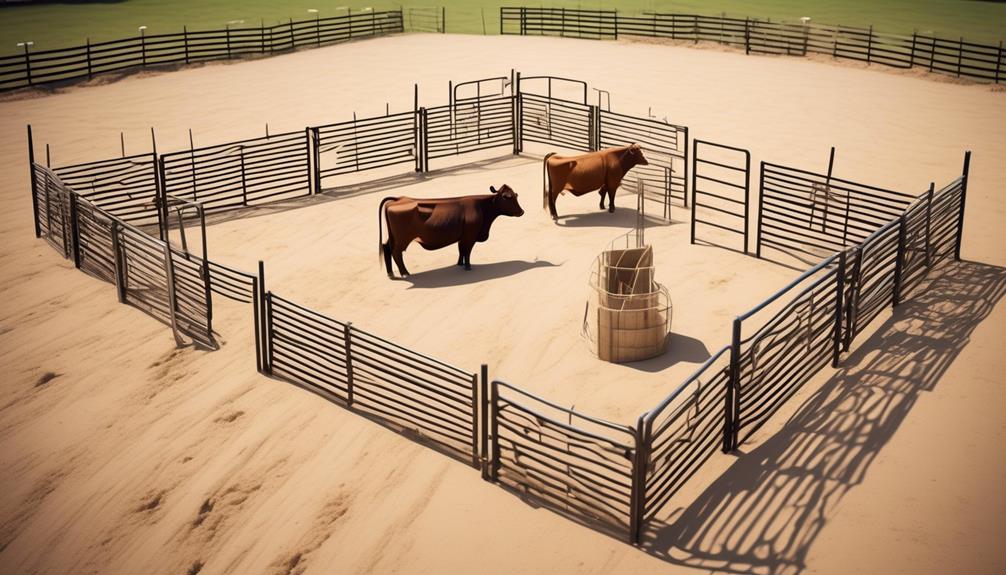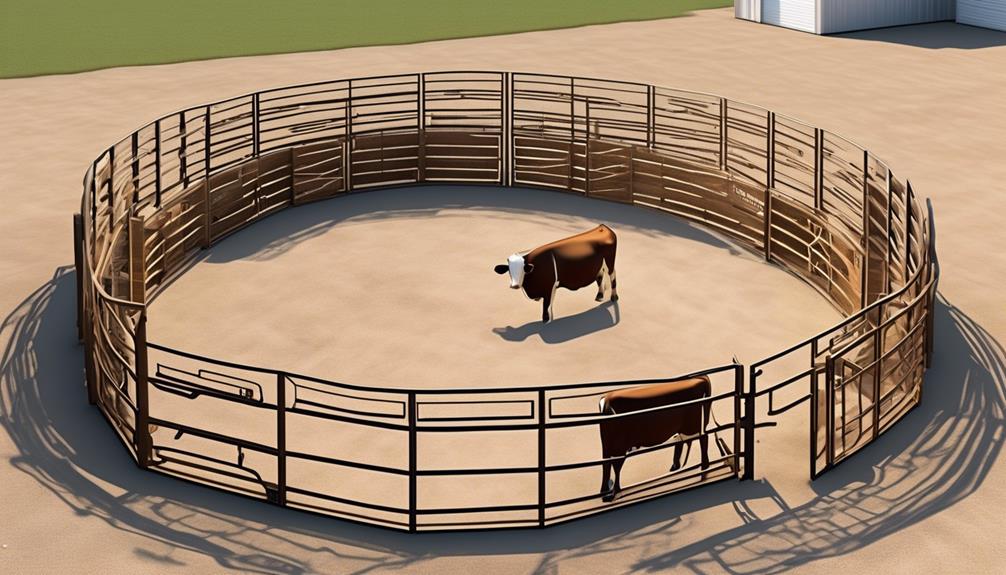Why Is Safe Cattle Corral Design Important?
When it comes to handling cattle, safe corral design is as crucial as a sturdy fence is to a ranch. You may not realize it, but the layout and features of a cattle corral can significantly impact the safety of both the animals and the handlers.
From minimizing stress to preventing injuries, a well-designed corral can make all the difference in the world. But why exactly is safe cattle corral design important? Well, let's just say it goes far beyond just keeping everyone out of harm's way.
Importance of Safety in Cattle Handling

Ensuring safety in cattle handling is essential for preventing accidents and maintaining a secure environment for both the animals and the handlers. Cattle welfare and worker safety are of utmost importance in any cattle corral design.
When handling cattle, it's critical to prioritize their welfare. This means providing them with a stress-free environment, minimizing fear, and ensuring their physical well-being. A well-designed corral not only prevents injuries to the animals but also facilitates easier handling and reduces the stress they experience.
Additionally, worker safety is paramount. By implementing proper safety measures, such as non-slip flooring, secure handling facilities, and clear escape routes, the risk of accidents for the handlers can be significantly reduced.
Prioritizing the safety of both cattle and workers also has economic benefits. When cattle are handled in a low-stress environment, they're less likely to become agitated, which can result in weight loss and decreased meat quality. By ensuring their welfare and minimizing stress, handlers can contribute to the overall productivity and profitability of the operation.
Moreover, prioritizing worker safety reduces the likelihood of workplace accidents, which can lead to costly injuries and legal issues.
Efficient Layout for Cattle Corrals
For an efficient layout for cattle corrals, prioritize clear pathways and easy access for handling the animals. Efficient design is crucial for maximizing space utilization and ensuring smooth cattle handling operations. When planning the layout, consider the flow of cattle from entry to exit, and strategically position gates and alleys to facilitate the movement of animals. This will help minimize stress on the cattle and improve the overall efficiency of handling tasks.
Ensure that the layout allows for easy access to all areas of the corral for maintenance and cleaning. Designing the corral with efficient space utilization in mind means making the most of the available area without overcrowding or creating bottlenecks. This can be achieved by using curved alleys and circular pen designs to encourage the natural movement of cattle, reducing the need for excessive prodding or forcing.
Efficient design also involves considering the location of water sources, feeders, and holding pens within the corral to minimize the distance cattle need to travel for essential resources. By strategically placing these elements, you can optimize the use of space and reduce unnecessary movement, ultimately saving time and energy for both the animals and handlers.
Incorporating these principles into the layout of cattle corrals will contribute to a more streamlined and effective operation, allowing for smoother cattle handling and overall improved efficiency.
Considerations for Cattle Behavior

Understanding cattle behavior is essential for creating an effective and safe corral design that promotes efficient handling and minimizes stress on the animals. When designing a cattle corral, it's crucial to consider cattle psychology and behavioral patterns.
Cattle are prey animals, and their natural instincts drive their behavior. They have a strong herd instinct and are sensitive to their surroundings. Being aware of these behavioral traits is key to creating a corral design that minimizes stress and maximizes handling efficiency.
Cattle tend to move in a circular pattern, so incorporating curved chutes and alleys can help facilitate the flow of cattle through the corral. This design mimics their natural movement, making it easier to guide them without causing undue stress. Additionally, understanding the flight zone, which is the personal space around an animal, is essential for effective handling. A well-designed corral should take into account the flight zone, allowing handlers to work within it to reduce stress on the animals.
Furthermore, considering cattle psychology when designing a corral involves minimizing visual distractions and shadows, as these can spook the animals. Solid sides on chutes and alleys can help prevent distractions and provide a sense of security for the cattle.
Key Elements of Cattle Corral Design
When designing a cattle corral, consider incorporating curved chutes and alleys to facilitate the natural circular movement of the animals, promoting efficient handling and minimizing stress. Efficient handling of cattle is essential for both the well-being of the animals and the productivity of the operation.
Curved chutes and alleys are key elements in cattle corral design that contribute significantly to the efficient handling of livestock. These curved structures help to guide the animals smoothly through the corral, reducing the need for excessive force or prodding, which can cause unnecessary stress to the cattle.
Additionally, the layout of the corral should be designed with animal welfare in mind. Providing sufficient space for the animals to move comfortably within the chutes and alleys is crucial. This not only ensures the safety of the cattle handlers but also contributes to the overall well-being of the livestock. A well-designed corral layout that considers the natural behavior of cattle can go a long way in minimizing stress during handling procedures.
Furthermore, clear visibility and access points for handlers should be integrated into the design to allow for smooth and safe movement within the corral. This enhances the overall efficiency of cattle handling operations while also prioritizing the safety of both the animals and the handlers.
Safe Handling Techniques for Cattle

To ensure the safety of both the cattle and the handlers, implement proper and effective handling techniques when working with livestock. Understanding cattle behavior is crucial for safe handling. Cattle are prey animals, so they're naturally cautious and can easily become stressed. When handling cattle, it's important to move slowly and calmly, avoiding sudden movements or loud noises that may startle them. Approaching cattle from their field of vision and utilizing curved alleys instead of sharp corners can help reduce stress and improve their movement through the handling facility.
Effective stress management is essential during cattle handling. Minimize loud noises, use non-slip flooring in corrals and chutes, and ensure that handling equipment is in good working condition to prevent accidents that could lead to increased stress for the animals. Additionally, providing cattle with familiar surroundings and handling them in a consistent manner can help reduce stress and improve their overall welfare.
When working with cattle, it's important to be observant and responsive to their behavior. Pay attention to signs of stress, such as vocalizations, excessive movement, or defensive postures, and adjust handling techniques accordingly. Using low-stress cattle handling methods can't only improve the safety of the handlers but also enhance the well-being of the animals.
Minimizing Stress in Cattle Handling
Implementing low-stress handling techniques is crucial for minimizing stress in cattle and ensuring the safety of both the animals and the handlers. By understanding cattle behavior and employing stress reduction strategies, you can create a calm and controlled environment for handling cattle.
Here are some important techniques to consider:
- Quiet Handling: Move calmly and quietly around the cattle to avoid startling them. Sudden movements or loud noises can agitate the animals, leading to increased stress levels.
- Proper Herd Management: Pay attention to the herd dynamics and minimize isolation of individual animals. Cattle are social animals, and separating them from their herd can cause distress.
- Gentle Sorting and Penning: Use low-pressure methods to sort and pen cattle. Avoid excessive prodding or rough handling, as this can lead to heightened anxiety and stress.
- Effective Facility Design: Ensure that the cattle handling facilities are well-designed to facilitate smooth movements and minimize the need for forceful handling. Curved chutes, non-slip flooring, and proper lighting can contribute to a more relaxed and stress-free environment for the animals.
Ergonomic Features in Cattle Corrals

Consider incorporating ergonomic features such as adjustable railings and easy-access gates to enhance the efficiency and safety of your cattle corrals.
Ergonomic design in cattle corrals focuses on creating a layout that's comfortable and efficient for both the animals and the handlers. One key feature to consider is adjustable railings. These railings can be raised or lowered to accommodate different sizes of cattle, ensuring a secure and comfortable fit during handling.
Additionally, incorporating curved chutes and races can help reduce stress on the animals and improve handling efficiency. The curved design encourages cattle to move forward without the need for excessive prodding, making the handling process smoother and less stressful for both the animals and the handlers.
Easy-access gates are another important ergonomic feature to consider. These gates should be strategically placed to allow for easy entry and exit for both cattle and handlers. By providing convenient access points, you can streamline the movement of cattle through the corral and minimize the time and effort required for handling.
Furthermore, implementing non-slip flooring in the corral can improve traction for the cattle, reducing the risk of slips and falls during handling procedures.
Best Practices for Cattle Corral Safety
For optimal cattle corral safety, prioritize clear signage indicating restricted areas and proper handling procedures. This will help prevent accidents and ensure that all individuals are aware of the potential risks within the cattle corral.
Implementing best practices is crucial when it comes to safe handling and animal welfare. Here are some guidelines to ensure the safety and well-being of both the cattle and the handlers:
- Proper Signage: Clearly mark restricted areas and provide instructions for safe handling. This will help prevent accidents and ensure that all individuals are aware of the potential risks within the cattle corral.
- Regular Maintenance: Conduct routine inspections and maintenance to ensure that all equipment, such as gates, chutes, and fences, are in good working condition. This will help minimize the risk of malfunctions that could lead to injuries or escapes.
- Training and Education: Provide comprehensive training for personnel involved in handling cattle. Properly trained handlers are essential for safe and efficient cattle management.
- Stress Reduction Techniques: Implement strategies to minimize stress for the cattle during handling procedures. This may include using non-slip flooring, providing shade, and avoiding excessive noise.
Frequently Asked Questions
What Are the Common Mistakes or Oversights That Lead to Unsafe Cattle Corral Design?
When designing cattle corrals, common mistakes and oversights can lead to unsafe conditions. Ignoring the impact of weather and environmental factors on cattle handling can result in accidents and stress for both the animals and handlers.
How Can Weather and Environmental Factors Impact the Safety of Cattle Handling in a Corral?
When dealing with cattle handling in a corral, weather and environmental factors can significantly impact safety. Considering the impact of weather and environmental considerations is crucial for ensuring the safety of both cattle and handlers.
Are There Any Specific Regulations or Standards That Need to Be Followed When Designing a Cattle Corral for Safety?
When designing a cattle corral for safety, it's crucial to adhere to regulations and standards. This ensures proper oversight and addresses environmental impact. Human behavior, communication, and technology integration, as well as automation safety, are also important considerations.
What Role Does Human Behavior and Communication Play in Ensuring Safe Cattle Handling in a Corral?
In ensuring safe cattle handling in a corral, human behavior and communication play crucial roles. By understanding cattle behavior and using effective communication, you can improve safety, integrate technology, and comply with safety regulations.
Can Technology or Automation Be Integrated Into Cattle Corral Design to Improve Safety?
Integrating technology and automation in cattle corral design can greatly improve safety. With the right systems in place, you can enhance efficiency, minimize human risk, and ensure better handling of cattle.
Conclusion
In conclusion, safe cattle corral design is essential for the well-being of both the animals and the handlers.
By considering the layout, behavior, and key elements of corral design, as well as implementing safe handling techniques and ergonomic features, you can ensure a safer and more efficient cattle handling process.
Minimizing stress and following best practices for cattle corral safety will ultimately lead to better outcomes for everyone involved.
